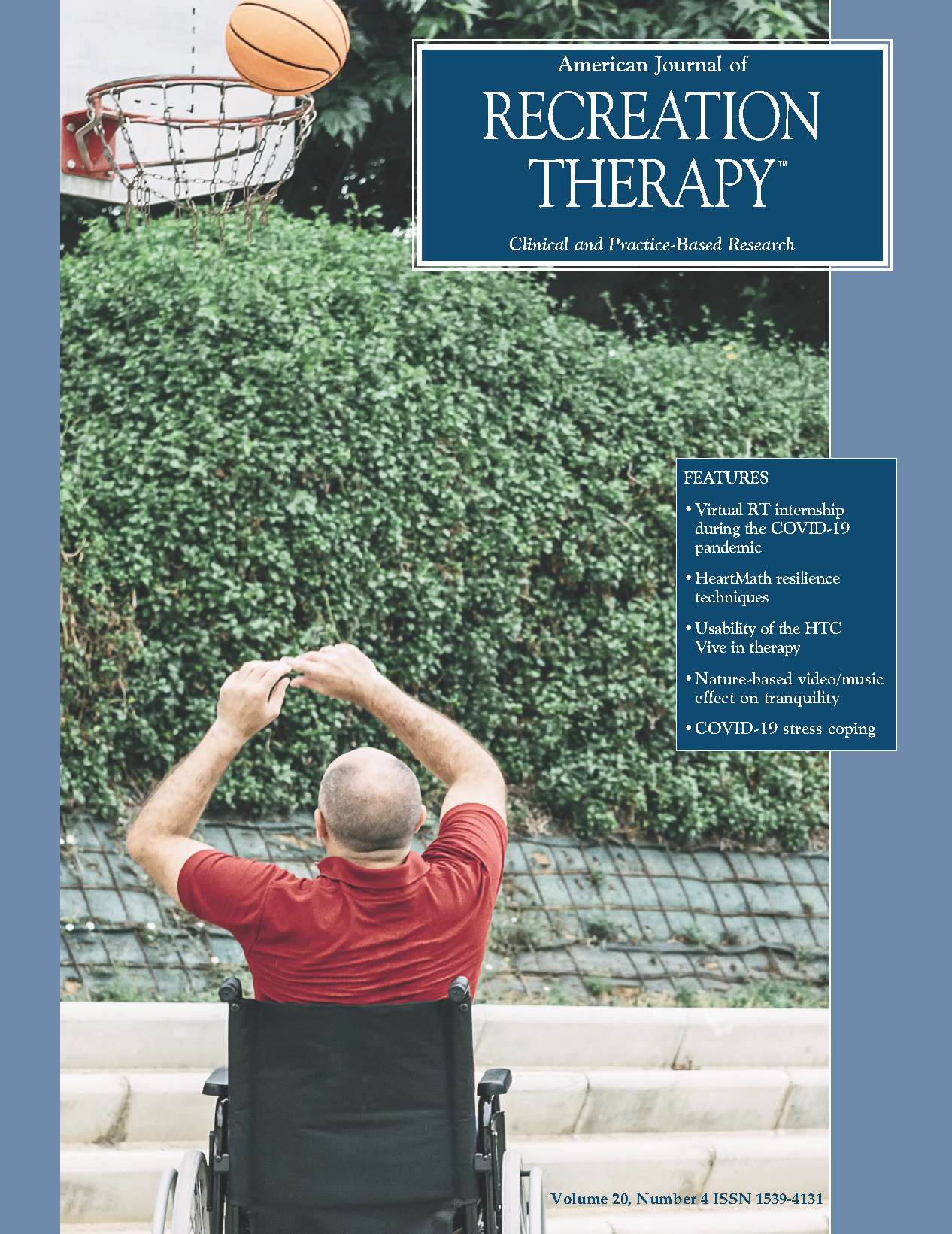Usability of the HTC Vive virtual reality system in recreational therapy
DOI:
https://doi.org/10.5055/ajrt.2021.0243Keywords:
HTC Vive, recreational therapy, technology, usability, virtual realityAbstract
Commercial virtual reality (VR) systems have become increasingly popular, affordable, and accessible in recent years. Resultantly, recreational activities involving VR are providing new ways to engage in leisure experiences and innovative treatments in the health care arena. Little is known, however, regarding the usability of commercial VR systems for recreational therapists and their clients. Therefore, the purpose of this study was to evaluate the usability of a popular commercial VR system, the HTC Vive, in terms of its potential use in recreational therapy practice. Using a cross-sectional design, data were collected from recreational therapy professionals (N = 8) working in diverse service settings. Following exposure to the HTC Vive equipment through a professional workshop that included didactic instruction and clinical role-play activities, participants evaluated the system’s usability for themselves as well as for the clients they serve. Data collected through both an online survey and a focus group discussion revealed strong agreement from the therapists that the HTC Vive is a usable commercial VR system for themselves as well as their clients. Specific comments related to the head-mounted display (HMD), controllers, sensors/base stations, positioning, and Steam software provide valuable insights on features viewed positively, possible adaptations for specific client groups, and unique considerations by service setting.
References
Petrov C: 43 Virtual reality statistics that rock the market in 2020. Techjury. Available at https://techjury.net/blog/virtual-reality-statistics/. Accessed October 19, 2020.
Greenwald W: The best VR headsets for 2020. PCMag. Available at https://www.pcmag.com/picks/the-best-vr-headsets. Published. 2020. Accessed October 18, 2020.
Park J, Chung Y: The effects of robot-assisted gait training using virtual reality and auditory stimulation on balance and gait abilities in persons with stroke. NRE. 2018; 43: 227-235. DOI: 10.3233/NRE-172415
Resnik L, Etter K, Klinger SL, et al.: Using virtual reality environment to facilitate training with advanced upper-limb prosthesis. JRRD. 2011; 48(6): 707-718.
Burke SL, Bresnahan T, Li T, et al.: Using virtual interactive training agents (ViTA) with adults with autism and other developmental disabilities. J Autism Dev Disord. 2018; 48: 905-912. DOI: 10.1007/s10803-017-3374-z
Maskey M, Rodgers J, Grahame V, et al.: A randomized controlled feasibility trial of immersive virtual reality treatment with cognitive behaviour therapy for specific phobias in young people with autism spectrum disorder. J Autism Dev Disord. 2019; 49: 1912-1927. DOI: 10.1007/s10803-018-3861-x
Harvey PD, Khan A, Atkins A, et al.: Virtual reality assessment of functional capacity in people with schizophrenia: Associations with reduced emotional experience and prediction of functional outcomes. Psychiatry Res. 2019; 277(December 2018): 58-63. DOI: 10.1016/j.psychres.2019.01.045
ATRA: About recreational therapy: What is recreational therapy? Available at https://www.atra-online.com/page/AboutRecTherapy. Accessed October 12, 2020.
Occupational outlook handbook: Recreational therapists. Available at https://www.bls.gov/ooh/healthcare/recreational-therapists.htm. US Bureau of Labor Statistics. Published 2019. Accessed October 18, 2020.
Shackel B: Usability—Context, framework, definition, design and evaluation. Interact Comput. 2009; 21(5-6): 339-346. DOI: 10.1016/j.intcom.2009.04.007
Holden H, Rada R: Understanding the influence of perceived usability and technology self-efficacy on teachers’ technology acceptance. J Res Technol Educ. 2011; 43(4): 343-367. DOI: 10.1080/15391523.2011.10782576
Preece J, Rodgers H: Interaction Design beyond Human-Computer Interaction. New York: John Wiley & Sons Inc., 2002.
Kushniruk AW, Patel VL: Cognitive and usability engineering methods for the evaluation of clinical information systems. J Biomed Inform. 2004; 37: 56-76. DOI: 10.1016/j.jbi.2004.01.003
Virzi RA: Refining the test phase of usability evaluation: How many subjects is enough? Hum Factors. 1992; 34(4): 457-468. DOI: 10.1177/001872089203400407
Hwang W, Salvendy G: Number of people required for usability evaluation: The 10 ± 2 rule. Commun ACM. 2010; 53(5): 130-133. DOI: 10.1145/1735223.1735255
VIAR: Virtual reality market size in 2018 with forecast for 2019: How good was 2018 for VR? Available at https://www.viar360.com/virtual-reality-market-size-2018/. Published 2018. Accessed October 19, 2020.
Suznjevic M, Mandurov M, Matijasevic M: Performance and QoE assessment of HTC Vive and Oculus Rift for pick-and-place tasks in VR. 2017 Ninth Int Conf Qual Multimed Exp. 2017: 1-3. DOI: 10.1109/QoMEX.2017.7965679.
Borrego A, Latorre J, Alcañiz M, et al.: Comparison of Oculus Rift and HTC Vive: Feasibility for virtual reality-based exploration, navigation, exergaming, and rehabilitation. Games Heal J Res Dev Clin Appl. 2018; 7(3): 151-156. DOI: 10.1089/g4h.2017.0114
Durbin J: Oculus Touch vs. HTC Vive—Which is the better VR controller? Available at https://uploadvr.com/oculustouch-vs-htc-vive-better-controller/. Upload. Published 2016. Accessed October 19, 2020.
Moon B: HTC VIVE and VIVE PRO comparison. Best Buy Blog. Available at https://blog.bestbuy.ca/wearabletechnology/virtual-reality/htc-vive-and-vive-pro-comparison. Published 2018. Accessed October 19, 2020.
Gepp M: Roomscale 101—An introduction to Roomscale VR. VIVE Blog. Available at https://blog.vive.com/us/2017/10/25/roomscale-101/. Published 2017. Accessed February 9, 2020.
Roberson B: Oculus Rift vs. HTC Vive. Digital Trends. Available at https://www.digitaltrends.com/virtual-reality/oculus-rift-vs-htc-vive/. Published 2020. Accessed October 19, 2020.
VIVE Ready Computers: HTC Corporation. Available at https://www.vive.com/sea/ready/. Published 2020. Accessed October 19, 2020.
Tom’s Guide Forum: What does each led status light mean on the HTC Vive controller. Available at https://forums.tomsguide.com/faq/what-does-each-led-status-lightmean-on-the-htc-vive-controller.110388/. Published 2016. Accessed July 14, 2021.
HTC Corporation: Vive pro Hmd User Guide. Available at https://dl4.htc.com/Web_materials/Manual/Vive_HMD/User_Guide/VIVE_Pro_HMD_User_Guide.pdf. 2020.
VR cover: Available at https://vrcover.com/. Accessed July 14, 2021.
Hales M: Your vr spending spree is not over—Htc Vive accessory guide. Turbosquid. Available at https://blog.turbosquid.com/2016/06/13/your-vr-spending-spree-not-quite/ Published 2013. Accessed July 14, 2021.
Skywin Design: Skywin VR tripod stand HTC vive compatible sensor stand and base station for vive sensors or oculus rift constellation (2-pack). Available at https://skywin.info/collections/vive/products/skywin-vr-tripod-stand-htcvive-compatible-sensor-stand-and-base-station-for-vivesensors-or-oculus-rift-constellation-2-pack. Published 2021.
Accessed July 14, 2021.
Published
How to Cite
Issue
Section
License
Copyright 2000-2025, Weston Medical Publishing, LLC and American Journal of Recreation Therapy. All Rights Reserved.


